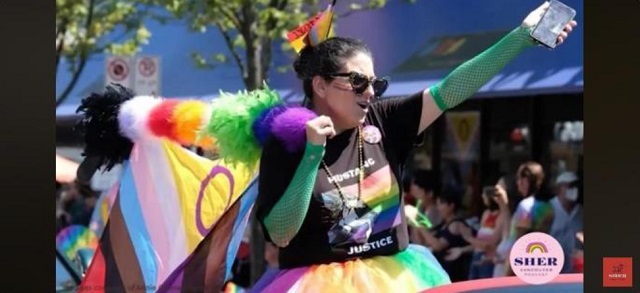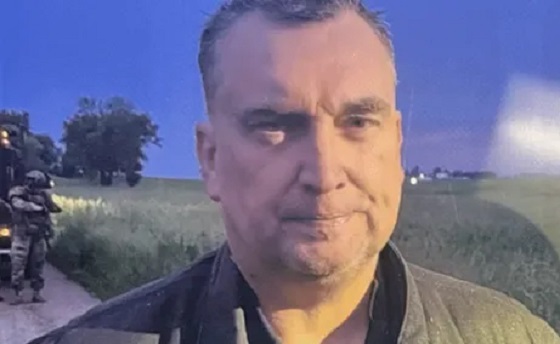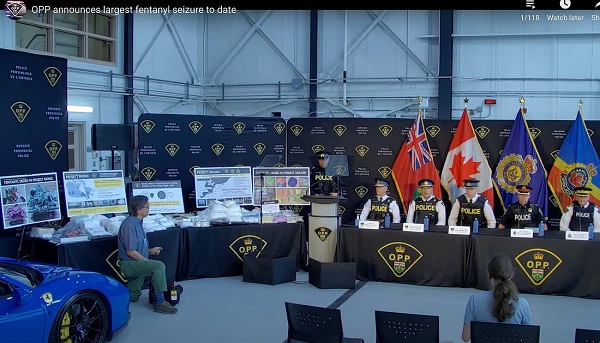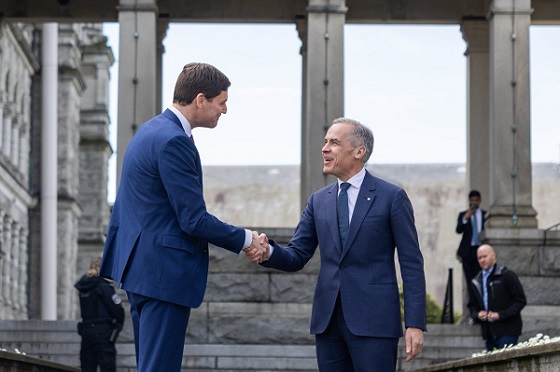Frontier Centre for Public Policy
The tale of two teachers

From the Frontier Centre for Public Policy
By Jim McMurtry
Some have criticized me for stating that the good, as well as the bad, of residential schools should be recognized. I stand by that statement…. Others have criticized me for stating that the Truth and Reconciliation Report was not as balanced as it should be. I stand by that statement as well.
At L.A. Matheson, a high school in Surrey, B.C., a poster in Annie Ohana’s classroom suggests society is too moralistic about sex work, the quote coming from an avowed Satanist. National Post writer Jamie Sarkonak described her classroom in this way: “The walls are covered with Social Justice posters. Some of them sloganeer about ‘decolonization,’ others ‘inflame racial politics.’” Ohana drapes herself in a Pride flag and speaks openly of her pansexuality as well as her subscription to wokeism, identity politics, Social Justice, and DEI.
In March Ohana appeared on CTV after being roundly criticized on X by an Ottawa teacher, Chanel Pfahl, the latter chased out of the profession a few years ago for questioning Critical Race Theory. Ohana said that Pfahl “seems to be making a lot of assumptions that were simply based on misinformation, lies, and in fact, puts myself and other teachers and students and my community in danger.” She also argued she was teaching about “critical thinking” and creating “empowered citizens that can speak up for themselves.” A Canadian flag hangs forlornly in her classroom, atop it is scrawled, “No pride in genocide.”
So far, she has faced no direct consequences for her political position or trying to indoctrinate her students. Indeed, she has won three teaching awards.
I, on the other hand, was walked out of my classroom and career for suggesting the only thing buried in Kamloops was the truth. In the eyes of my employer, I had put students and the community in danger by saying students who died while enrolled at a residential school did so from disease and not murder.
Northrop Frye wrote in The Great Code that the aim is “to see what the subject means, not to accept or reject it.” There is nothing wrong with the teaching of either me or Ohana as long as we are not steering students toward belief. In a 100-page investigation report on my teaching, an assistant superintendent of the Abbotsford School District wrote:
It in my view cannot be overemphasized that Mr. McMurtry having no knowledge of his students and more particularly whether any of these students had Indigenous descent in making his comments that provoked a strong student response and which was contrary to the school’s message of condolences and reconciliation. Regardless of his intent he left students with the impression some or all the deaths could be contributed to ‘natural causes’ and that the deaths could not be called murder or cultural genocide.
My fault was that I didn’t promote a “message of condolences and reconciliation.” Not only was this message never communicated to teachers, the message runs counter to the educational aim of seeing what a subject means. The message is also that the deaths of at least some Indian residential school children were attributable to murder, for which there is still no evidence.
Senator Lynn Beyak was the first prominent Canadian to wade into the increasingly turbulent waters of Indian residential schools. Labelled a racist and facing the prospect of ejection from the Senate, she retired in 2021 from her senate position but not from her convictions.
Some have criticized me for stating that the good, as well as the bad, of residential schools should be recognized. I stand by that statement…. Others have criticized me for stating that the Truth and Reconciliation Report was not as balanced as it should be. I stand by that statement as well.
George Orwell wrote in 1945 in an introduction to Animal Farm, “At any given moment there is an orthodoxy, a body of ideas of which it is assumed that all right-thinking people will accept without question. It is not exactly forbidden to say this, that or the other, but it is ‘not done’ to say it.” Queen’s law professor Bruce Pardy wrote last year: “A new standard of practice is emerging for Canadian professionals: be woke, be quiet, or be accused of professional misconduct.”
Annie Ohana is a better approximation of that mythically average teacher than I. Most teachers appear woke or know enough to be quiet and go along, standing for land acknowledgments, using individualized pronouns with students, speaking of gender identity and sexual orientation, distinguishing students based on race, reading Social Justice books over literary classics, and accepting revisionist history. They go to school wearing the right colour for the occasion: rainbow, pink, orange, red, or black. At staff meetings they are woke and quiet.
I am an avatar of Lynn Beyak, standing outside the orthodoxy and condemned by “all right-thinking people.” Our issue is also the same. Indian residential schools were not the genocidal project that federal members of parliament voted as a genocide on October 27, 2022.
The Truth and Reconciliation Commission, headed by two Indigenous men and a woman married to an Indigenous man, travelled for six years across Canada, and heard from 6000 former students. The Commission’s bias was evident in its final report:
Physical genocide is the mass killing of the members of a targeted group, and biological genocide is the destruction of the group’s reproductive capacity. Cultural genocide is the destruction of those structures and practices that allow the group to continue as a group. States that engage in cultural genocide set out to destroy the political and social institutions of the targeted group. Land is seized, and populations are forcibly transferred and their movement is restricted. Languages are banned. Spiritual leaders are persecuted, spiritual practices are forbidden, and objects of spiritual value are confiscated and destroyed. And, most significantly to the issue at hand, families are disrupted to prevent the transmission of cultural values and identity from one generation to the next. In its dealing with Aboriginal people, Canada did all these things.
What the final report does not mention is:
o the educational value of the schools;
o the alternative was no education at all in remote areas where a day school was not feasible;
o that both Indigenous chiefs and parents saw them as a treaty right and petitioned to keep them open into the sixties;
o that parents had to apply to send their children to residential schools;
o that the mandatory attendance which began in 1920 was to go to school (one-third going to day school, one-third to residential school, and one-third never going to any school);
o that the schools took in orphans and served as a refuge for children and in some cases adults who were abused on the reserve or without the necessities of life; and
o that many former students testified their time there was the happiest in their lives.
My natural allegiance is to fellow teachers, and I don’t doubt that Annie Ohana and others within the Critical Social Justice educational movement teach their students about critical thinking and create empowered citizens that can speak up for themselves. However, such critical thinking should also be directed against the orthodoxy these teachers are imposing on captive groups of students. As well, if their students are indeed empowered citizens, they should come to their own conclusions, no matter the ideological perspective of their teacher.
Jim McMurtry, PhD, was formerly a principal of Neuchâtel Junior College in Switzerland and a college lecturer, but mostly he was a teacher. He lives in Surrey, B.C.
Alberta
Too Graphic For A Press Conference But Fine For Kids In School?

From the Frontier Centre for Public Policy
By Lee Harding
Alberta moves to remove books after disturbing content, too graphic for media to view, was found in schools
Should elementary school children be given books to read with harsh insults against minorities, depictions of oral sex, and other disturbingly graphic and explicit content?
Such books have been in some Alberta elementary schools for a while, and in many school libraries across Canada.
In late May, the Alberta government announced it would establish new guidelines regarding age-appropriate materials in its schools. A government press release included quotes with disturbing content, but at a press conference, Education Minister Demetrios Nicolaides said some book illustrations could not be shown.
“I would show these images to all of you here and to the media, but they are too graphic for a live-stream media event. These examples … illustrate the kind of content that raises concerns amongst parents,” Nicolaides said.
You don’t say? This seems like the sort of stuff no one, except a pervert in a park, would dream of showing to a child. Ironically, the inability to publicize such graphic materials is part of the reason they have been shown to children with little public awareness.
Citizens’ group Action4Canada (A4C) has claimed its activism played a pivotal role in the Alberta decision. The organization has compiled a 36-page document online with examples of objectionable content in Canadian schools. Among the worst is Identical by Ellen Hopkins, which includes graphic descriptions of a little girl being molested by her father.
A4C founder Tanya Gaw has repeatedly tried to raise concerns about objectionable books with school boards, often without success. In some cases, she isn’t even allowed on the agenda if she states her topic upfront. When she is permitted to speak, she’s frequently cut off as soon as she begins quoting from the books, preventing the content from entering the public record.
In January 2023, Gaw made an online presentation to a school board in Mission, B.C. regarding materials in their schools. As she began to screenshare what was there, some board members objected, saying such permission had not been given in advance.
One month later, the board banned Action4Canada from making any further presentations. In later media interviews, the board chair justified the decision by saying Gaw’s PowerPoint contained some graphic and “inappropriate images.”
Exactly, and that is the problem. A recent check showed Mission’s school division only removed four of 15 books A4C objected to. Gaw is just glad “Identical” is one of them.
Pierre Barns, a father from Abbotsford, B.C., made it his mission to notify school boards across Canada what was on their school shelves. An online search was all it took to confirm. A “reply all” from a board member at the Halton School District in Ontario was most ironic.
“I am concerned. This individual has included links to publications and videos which may contain illegal content,” she wrote.
“I’m not sure how to investigate the content of the email safely. Would you please advise us whether or not this person ought to be reported to police? Is there some action we should take?”
There probably was action they should have taken, such as removing the books, but that never happened. Later, they defended a biologically male teacher in their school division who made international headlines by wearing large prosthetic breasts to school.
The Alberta government has committed to conducting public consultations before implementing new policies. It’s a good time for parents and citizens there and in other provinces to speak up. A young mind is a terrible thing to corrupt, but unfortunately, some schools are part of this corrosive effort.
Lee Harding is a research fellow with the Frontier Centre for Public Policy.
Economy
Canada Treats Energy As A Liability. The World Sees It As Power

From the Frontier Institute for Public Policy
Research VP Marco Navarro-Genie warns that Canada’s future hinges on building energy infrastructure, not just expanding pipelines but forging a true North American energy alliance. With global demand rising and authoritarian regimes weaponizing energy, Ottawa’s dithering costs Canada $70 million daily. Sovereignty isn’t secured by speeches but by infrastructure. Until Canada sheds its regulatory paralysis, it will remain a discount supplier in a high stakes geopolitical game. Time to build.
Canada has energy the world is begging for, but ideology and red tape are holding us back
As Prime Minister Mark Carney met with U.S. President Donald Trump recently, energy should have been the issue behind every headline, whether mentioned or not. Canada’s future as a sovereign, economically resilient country will depend in no small part on whether the country seizes this moment or stalls out again in a fog of regulatory inertia and political ambivalence. Canada holds an underleveraged strategic card: the potential to be the world’s most reliable democratic energy supplier. Recent trade figures show Chinese imports of Canadian crude hit a record 7.3 million barrels in March, a direct result of newly expanded access to the Pacific via the Trans Mountain Expansion (TMX), a federally owned pipeline project that now connects Alberta crude to global markets through British Columbia’s coast. But one pipeline does not make a national strategy. Demand in Asia is growing fast. India is among the hungriest, but Canada’s infrastructure is nowhere near meeting that demand.
This matters not just for Canada, but for the United States as well. In a world where energy markets are weaponized and strategic reserves manipulated by authoritarian regimes, the case for a coordinated North American energy alliance is stronger than ever. Such an alliance should not erode national sovereignty. It should reinforce it, allowing Canada, the U.S. and Mexico to insulate themselves collectively from supply shocks and geopolitical blackmail while projecting democratic strength abroad.
But for that alliance to work, Canada must be a credible partner, not merely a junior supplier shackled by Ottawa-induced internal bottlenecks. While the U.S. has leveraged its shale revolution, LNG capacity and permitting reforms to pursue energy dominance, Canada dithers. Projects languish. Investment flees. And meanwhile, Canadian oil continues to flow south at a steep discount, only to be refined and resold, often back to us or our trading partners, at full global prices.

Yes, you read that right. Canada’s oil and gas is sold at a discount to U.S. customers, and that discount costs Canada more than $70 million every single day. The Frontier Centre for Public Policy has developed a real-time tracker to monitor these losses. This pricing gap exists because Canada lacks sufficient pipeline infrastructure to access overseas buyers directly, forcing producers to sell to the U.S., often at below-market rates.
Such massive losses should be unacceptable to any government serious about economic growth, geopolitical influence or environmental integrity. Yet Ottawa continues to speak the language of ambition while legislating the mechanics of paralysis. Stephen Guilbault’s statement that Canada already has enough pipelines speaks to more paralysis..
Canada’s energy infrastructure challenges are not just economic; they are matters of national defence. No country can claim to be secure while relying on another’s pipelines to transport its energy across its own territory. No country can afford to leave its wealth-producing regions boxed in by regulatory choke points or political resistance dressed as environmental virtue.
Our energy economy is fragmented. Western hydrocarbons are stuck inland and must pass through the U.S. to reach Eastern Canada or global markets eastward. This weakens national unity and leaves us exposed to foreign leverage. It also creates strategic vulnerabilities for our allies. American industries depend on Canadian crude. So do U.S. Gulf Coast refineries. And while American officials continue to treat energy as a tool of diplomacy and economic leverage, using energy exports to build alliances and reduce reliance on unstable regimes, Canada treats it as a domestic liability.
We need to shift the frame. Infrastructure isn’t just about steel in the ground; it’s the backbone of strategic autonomy. Pipelines, export terminals and utility corridors would allow Canada to claim its place in the emerging geopolitical order. They would also signal to global investors that Canada is open for business and capable of delivering returns without political obstruction.
The U.S. wants a stable, competent partner to help meet global energy needs. Increasingly, so does the rest of the world. But until we address our internal dysfunction and build, we’re stuck. Stuck watching global opportunities pass us by. Stuck selling low while others sell high. Stuck in a conversation about sovereignty we’re not structurally equipped to address, let alone win.
When Carney meets with Trump again, he would do well to remember that economic independence, not rhetorical unity, is the bedrock of sovereignty. Without infrastructure, Canada brings only words to a hard-power conversation.
Paraphrasing Thomas Hobbes, energy covenants without infrastructure are but words. It’s time to stop posturing and start building.
Marco Navarro-Genie is the vice-president of research at the Frontier Centre for Public Policy. He is co-author, with Barry Cooper, of Canada’s COVID: The Story of a Pandemic Moral Panic (2023).
-

 Health18 hours ago
Health18 hours agoLast day and last chance to win this dream home! Support the 2025 Red Deer Hospital Lottery before midnight!
-

 Business2 days ago
Business2 days agoCarney’s European pivot could quietly reshape Canada’s sovereignty
-

 Aristotle Foundation21 hours ago
Aristotle Foundation21 hours agoThe Canadian Medical Association’s inexplicable stance on pediatric gender medicine
-

 conflict1 day ago
conflict1 day ago“Evacuate”: Netanyahu Warns Tehran as Israel Expands Strikes on Iran’s Military Command
-

 Alberta2 days ago
Alberta2 days agoAlberta’s grand bargain with Canada includes a new pipeline to Prince Rupert
-

 Energy23 hours ago
Energy23 hours agoCould the G7 Summit in Alberta be a historic moment for Canadian energy?
-

 Bruce Dowbiggin23 hours ago
Bruce Dowbiggin23 hours agoWOKE NBA Stars Seems Natural For CDN Advertisers. Why Won’t They Bite?
-

 Crime23 hours ago
Crime23 hours agoMinnesota shooter arrested after 48-hour manhunt





